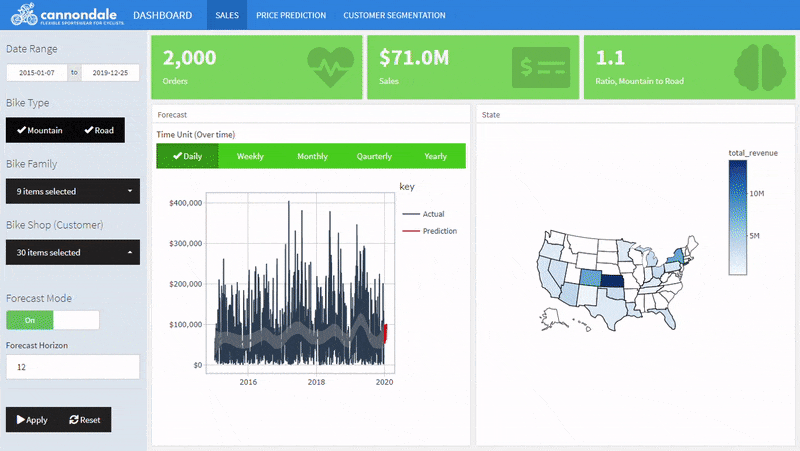

Product Dashboard
Product analytics dashboard with predictive analytics. You can use it to find insights about demographic trends or changes in customer behavior. It has a reporting feature for the real-time monitoring of activities on cycling product revenues.
Skills and deliverables
Data Science, Revenue Forecast, Price Prediction, Customer Segmentation
Challenge
Marketing domain, encounter several challenges related to price and revenue management, as well as customer retention. Setting the right pricing strategy to maximize revenue while remaining competitive requires careful consideration of market demand and customer perceptions.
Solution
Data science emerges as a powerful ally, offering effective solutions to the challenges of price and revenue management, as well as customer retention. By utilizing predictive pricing models and revenue forecasting techniques, businesses can set optimal prices and plan for future growth. Customer segmentation through data-driven insights enables personalized marketing efforts, fostering stronger customer relationships and retention. By leveraging these insights, marketers can make data-driven pricing decisions that strike the right balance between maximizing revenue and remaining competitive in the market.
Objectives
A product analytics dashboard helps you visualize customer behavior, revenue activity, and marketing impact so you can make informed decisions on how to improve product engagement.
Forecasting revenue
Enable marketers to analyze historical sales data, customer behavior, market trends, and other relevant factors to predict future revenue accurately.
Additionally, revenue forecasting enables marketers to track the effectiveness of their marketing strategies. By comparing actual revenue with forecasted revenue, they can assess the success of their marketing initiatives and make data-driven decisions to fine-tune their approaches for maximum impact.
Price prediction
Predictive pricing models enable marketers to adjust prices dynamically in response to changes in market demand and competitor actions. This agility ensures that prices are optimized to capitalize on opportunities and remain attractive to customers, ultimately leading to increased sales and revenue.
By optimizing pricing through data science, marketers can also improve their return on investment (ROI). When prices are set optimally, marketing efforts become more cost-effective, as higher-priced products can generate higher margins, while lower-priced items may attract more sales volume. With an optimized pricing strategy, marketers can allocate resources more efficiently and focus on campaigns that deliver the best ROI.
Furthermore, accurate price prediction enables marketers to avoid overpricing or underpricing products, preventing potential loss of customers due to high prices or leaving money on the table with low prices. This balance enhances customer satisfaction and loyalty, leading to increased customer retention.
Customer segmentation
Using data science for customer segmentation can prove immensely beneficial for marketers aiming to increase revenue and optimize their return on investment (ROI).
Data science techniques, such as machine learning algorithms and clustering methods, enable marketers to analyze vast datasets and group customers based on their shared characteristics, behaviors, and preferences.
-
Customer segmentation allows marketers to better understand their target audience, enabling them to create personalized and relevant marketing strategies.By tailoring messages and offerings to specific customer segments, marketers can improve customer engagement and satisfaction, leading to increased sales and revenue.
-
Allows marketers to identify and prioritize customer needs and pain points accurately. This knowledge helps in developing products and services that align with customer preferences, resulting in higher customer satisfaction and loyalty.
-
Enhances customer retention strategies. By understanding different customer segments, marketers can implement targeted retention efforts, such as personalized offers and loyalty programs, to strengthen customer relationships and reduce churn rates.
-
Aids in optimizing pricing strategies. Marketers can identify customer segments willing to pay premium prices for specific products or services, allowing for value-based pricing and increased revenue generation.
-
Data science-driven customer segmentation enables marketers to optimize their marketing campaigns. By tailoring marketing messages to specific customer segments, marketers can deliver more relevant and compelling content, leading to higher response rates and improved campaign performance.

